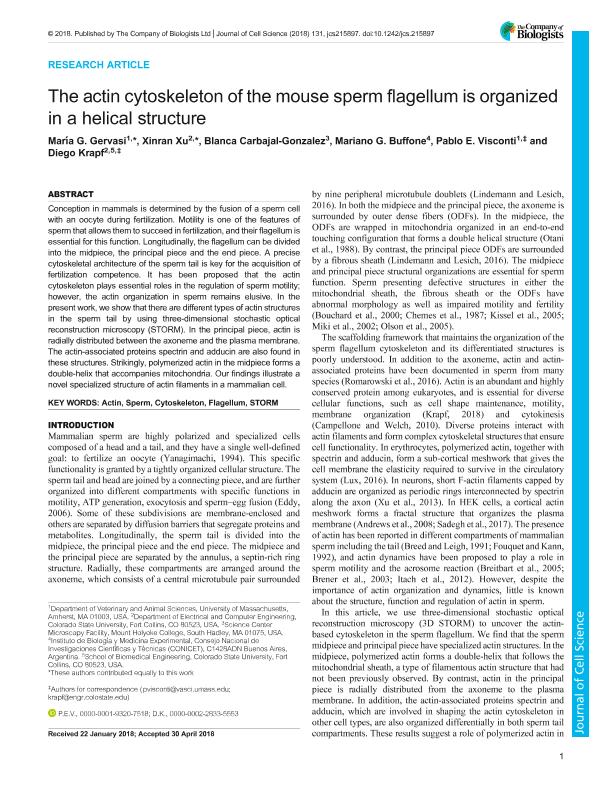Artículo
The actin cytoskeleton of the mouse sperm flagellum is organized in a helical structure
Gervasi, Maria Gracia ; Xu, Xinran; Carbajal Gonzalez, Blanca; Buffone, Mariano Gabriel
; Xu, Xinran; Carbajal Gonzalez, Blanca; Buffone, Mariano Gabriel ; Visconti, Pablo E.; Krapf, Diego
; Visconti, Pablo E.; Krapf, Diego
 ; Xu, Xinran; Carbajal Gonzalez, Blanca; Buffone, Mariano Gabriel
; Xu, Xinran; Carbajal Gonzalez, Blanca; Buffone, Mariano Gabriel ; Visconti, Pablo E.; Krapf, Diego
; Visconti, Pablo E.; Krapf, Diego
Fecha de publicación:
11/06/2018
Editorial:
Company of Biologists
Revista:
Journal of Cell Science
ISSN:
0021-9533
Idioma:
Inglés
Tipo de recurso:
Artículo publicado
Clasificación temática:
Resumen
Conception in mammals is determined by the fusion of a sperm cell with an oocyte during fertilization. Motility is one of the features of sperm that allows them to succeed in fertilization, and their flagellum is essential for this function. Longitudinally, the flagellum can be divided into the midpiece, the principal piece and the end piece. A precise cytoskeletal architecture of the sperm tail is key for the acquisition of fertilization competence. It has been proposed that the actin cytoskeleton plays essential roles in the regulation of sperm motility; however, the actin organization in sperm remains elusive. In the present work, we show that there are different types of actin structures in the sperm tail by using three-dimensional stochastic optical reconstruction microscopy (STORM). In the principal piece, actin is radially distributed between the axoneme and the plasma membrane. The actin-associated proteins spectrin and adducin are also found in these structures. Strikingly, polymerized actin in the midpiece forms a double-helix that accompanies mitochondria. Our findings illustrate a novel specialized structure of actin filaments in a mammalian cell.
Palabras clave:
SPERM
,
ACTIN
,
MITOCHONDRIA
,
FERTILIZATION
Archivos asociados
Licencia
Identificadores
Colecciones
Articulos(IBYME)
Articulos de INST.DE BIOLOGIA Y MEDICINA EXPERIMENTAL (I)
Articulos de INST.DE BIOLOGIA Y MEDICINA EXPERIMENTAL (I)
Citación
Gervasi, Maria Gracia; Xu, Xinran; Carbajal Gonzalez, Blanca; Buffone, Mariano Gabriel; Visconti, Pablo E.; et al.; The actin cytoskeleton of the mouse sperm flagellum is organized in a helical structure; Company of Biologists; Journal of Cell Science; 131; 11; 11-6-2018; 215897-215992
Compartir
Altmétricas



